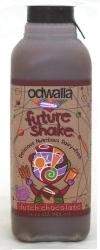Odwalla
American health food company
Odwalla Inc. was an American health food company that produced fruit juice, smoothies, and food bars. The company was founded in 1980 by Greg Steltenpohl, Gerry Percy, and Bonnie Bassett in Santa Cruz, California. Odwalla's products were known for their use of fresh, high-quality ingredients and were distributed throughout the United States.
History[edit | edit source]
Odwalla was established in 1980, initially selling fresh orange juice to local stores. The company quickly expanded its product line to include a variety of fruit and vegetable juices, as well as smoothies and food bars. In 1996, Odwalla faced a significant challenge when an outbreak of Escherichia coli O157:H7 was linked to its unpasteurized apple juice, resulting in a recall and a shift to pasteurization for its juice products.
In 2001, Odwalla was acquired by The Coca-Cola Company, which helped expand its distribution network and product offerings. Despite its success, Odwalla faced increasing competition in the health food market. In 2020, The Coca-Cola Company announced that it would discontinue the Odwalla brand, citing declining sales and changing consumer preferences. The brand was officially discontinued in 2021.
Products[edit | edit source]
Odwalla's product line included a variety of fruit and vegetable juices, smoothies, and food bars. Some of the popular flavors included:
Controversies[edit | edit source]
In 1996, Odwalla was involved in a major foodborne illness outbreak when several people were infected with Escherichia coli O157:H7 after consuming its unpasteurized apple juice. The outbreak resulted in one death and numerous illnesses. Following the incident, Odwalla implemented pasteurization for its juice products to ensure safety.
See also[edit | edit source]
References[edit | edit source]
| The Coca-Cola Company | ||||||||||||||||||||||
|---|---|---|---|---|---|---|---|---|---|---|---|---|---|---|---|---|---|---|---|---|---|---|
|
Search WikiMD
Ad.Tired of being Overweight? Try W8MD's physician weight loss program.
Semaglutide (Ozempic / Wegovy and Tirzepatide (Mounjaro / Zepbound) available.
Advertise on WikiMD
|
WikiMD's Wellness Encyclopedia |
| Let Food Be Thy Medicine Medicine Thy Food - Hippocrates |
Translate this page: - East Asian
中文,
日本,
한국어,
South Asian
हिन्दी,
தமிழ்,
తెలుగు,
Urdu,
ಕನ್ನಡ,
Southeast Asian
Indonesian,
Vietnamese,
Thai,
မြန်မာဘာသာ,
বাংলা
European
español,
Deutsch,
français,
Greek,
português do Brasil,
polski,
română,
русский,
Nederlands,
norsk,
svenska,
suomi,
Italian
Middle Eastern & African
عربى,
Turkish,
Persian,
Hebrew,
Afrikaans,
isiZulu,
Kiswahili,
Other
Bulgarian,
Hungarian,
Czech,
Swedish,
മലയാളം,
मराठी,
ਪੰਜਾਬੀ,
ગુજરાતી,
Portuguese,
Ukrainian
Medical Disclaimer: WikiMD is not a substitute for professional medical advice. The information on WikiMD is provided as an information resource only, may be incorrect, outdated or misleading, and is not to be used or relied on for any diagnostic or treatment purposes. Please consult your health care provider before making any healthcare decisions or for guidance about a specific medical condition. WikiMD expressly disclaims responsibility, and shall have no liability, for any damages, loss, injury, or liability whatsoever suffered as a result of your reliance on the information contained in this site. By visiting this site you agree to the foregoing terms and conditions, which may from time to time be changed or supplemented by WikiMD. If you do not agree to the foregoing terms and conditions, you should not enter or use this site. See full disclaimer.
Credits:Most images are courtesy of Wikimedia commons, and templates, categories Wikipedia, licensed under CC BY SA or similar.
Contributors: Prab R. Tumpati, MD







